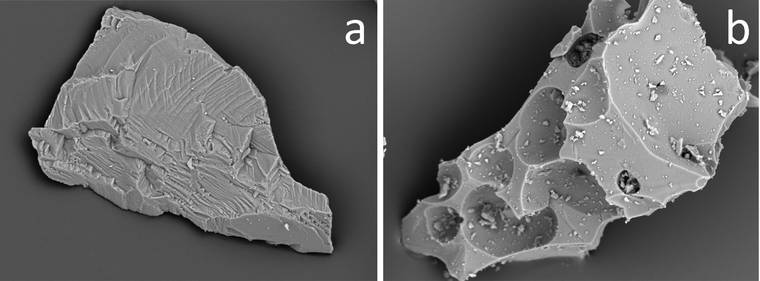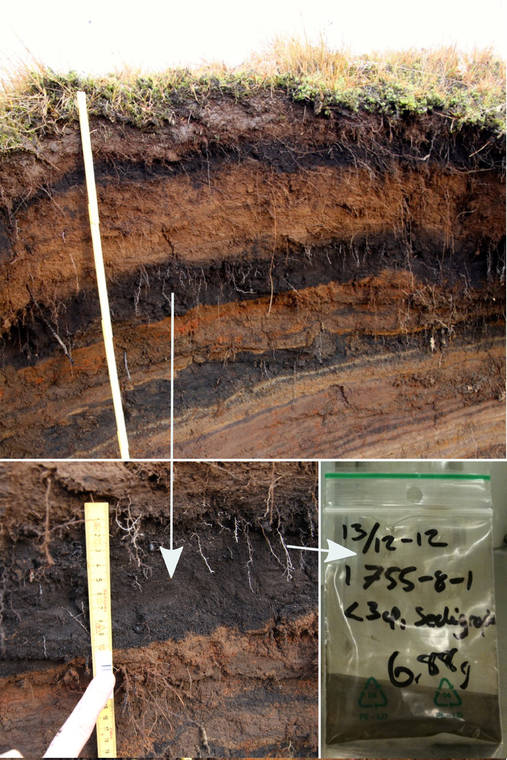Water, ash, and the great unknown of explosive volcanic eruptions

Scanning electron microprobe images show the complexity of tiny Icelandic ash grains (150 micron, or 0.006 inch). Image (a) shows a dense and blocky grain, and (b) shows a foamy grain. Photos by J. Schmith.

This section of brown Icelandic soil (top) contains 800 years of ash deposits erupted from five different volcanoes. The black layers, 5-10 cm (2-4 in) thick, are from Katla Volcano. A white arrow points to a closeup of the 1755 Katla ash deposit (lower left). The ash looks like specks of dust in the sample bag (lower right), but microprobe imaging reveals how complex the grain shapes are. (Photos by J. Schmith/USGS)
The presence of water in Halema’uma’u has sparked an important discussion about what the pond means for future eruptions at Kilauea Volcano. There are no written records of water at the summit, so to guide the discussion we need information about magma-water interaction from deposits of the past.
The presence of water in Halema’uma’u has sparked an important discussion about what the pond means for future eruptions at Kilauea Volcano. There are no written records of water at the summit, so to guide the discussion we need information about magma-water interaction from deposits of the past.
But how can we get that information? I set out to answer this very question some years ago, and like many scientific quests, it started with a frustrating discovery.
Sitting in my lab one defining afternoon, I was studying the explosive nature of Icelandic volcanoes at the University of Iceland. our grain shape analyzer sat in its lavender box on the lab bench, humming loudly, as a pump ran my sample of volcanic ash through a water-filled tubing system.
The grains went through an inch-long lens in front of a camera with a high-pitched shutter clicking manically at 30 frames per second. The screen next to the instrument showed a live stream of images with black particles on a light grey backdrop. In the sample bag, these same grains looked like tiny dust specks, but magnified on the screen, they came to life as abrasive, glassy shards of volcanic ash.
I had been in the lab for several hours that day and for weeks before that. My experiment built on the observation that ash generated by different types of volcanic explosions had different shapes. Ash from explosions caused by the expansion of magmatic gasses looked like tiny pieces of frozen foam with broken bubble walls. Ash from explosions in which hot magma interacted with liquid water looked like broken glass shards — dense and blocky.
This distinction was first observed in the 1970s using big, expensive electron microscopes to view a small selection of grains. During my study with the new shape analyzer, however, we had the opportunity to get information on many thousand grains all at once, and I intended to use that to characterize some puzzling big ash deposits in Iceland, and to look for a link with magma-water interaction.
When the aggravating shutter clicking finally stopped, I pressed “export data” on the screen and ran to my desk to get the first peek at my achievement. I held my breath as the computer worked to plot results from all 20,000 grains, and then gasped in disbelief. My plot came out with grain shapes all over the place with no systematic groupings at all. I tried another sample, then one more and yet another, and I felt crushed! Many months of hard work seemed useless.
After days of checking my instrument setup, the quality of my data, and digging through a lot of scientific papers, I finally had an idea. The old experiments had characterized only a few grains, so perhaps something was missing in the classification scheme. So, I went back to my photos of individual ash grains and started to classify their shapes according to how much they were influenced by broken bubbles and consequently by magmatic gas expansion.
The grains weren’t just foamy or dense. Instead, I saw a spectrum of shapes, from blocky shards with dense glass and no bubbles, then blocky shards with a few isolated bubbles, to progressively more foamy grains. This was exciting!
over the following weeks I worked to put this new information into a classification diagram. I collected new samples from different types of explosive eruptions for which I already knew if water was involved or not.
Some lab sessions later, I once again held my breath in front of my computer, but this time it worked! There was a predictable and systematic difference to the test samples. The Icelandic ash turned out to be the result of both magmatic gas expansion and magma-water interaction. We now have a more flexible way to characterize how water influences volcanic eruptions just from looking at the shapes of tiny ash grains.
I am now in Hawaii, collecting samples of ash from Kilauea to figure out what role water has played in past summit eruptions. Results will be discussed in a future Volcano Watch, so stay tuned!
The USGS Hawaiian Volcano observatory continues to monitor and issue regular updates on Hawaiian volcanoes while also heeding Federal and CDC, as well as State and County guidelines to maintain the health and safety of our staff and the community. We will also continue to issue weekly Volcano Watch articles written by HVO scientists and affiliates.
Today’s article is by Johanne Schmith, an Associate Postdoc funded by the Carlsberg Foundation Internationalisation Fellowship, whose work on Kilauea was the subject a recent Volcano Watch.
Visit https://volcanoes.usgs.gov/observatories/hvo/ for past Volcano Watch articles, Kilauea and Mauna Loa updates, volcano photos, maps, recent earthquake info, and more. Email questions to askHVo@usgs.gov.
Volcano Activity Updates
Kilauea Volcano is not erupting. Its USGS Volcano Alert level remains at NoRMAL (https://volcanoes.usgs.gov/vhp/about_alerts.html). Kilauea updates are issued monthly.
Kilauea monitoring data over the past month showed no significant changes in seismicity, sulfur dioxide emission rates, or deformation. The water lake at the bottom of Halema’uma’u continued to slowly expand and deepen.
Mauna Loa is not erupting. Its USGS Volcano Alert level remains at ADVISoRY. This alert level does not mean that an eruption is imminent or that progression to an eruption is certain. Mauna Loa updates are issued weekly.
This past week, HVo recorded about 42 small-magnitude earthquakes, all less than M2.0, beneath the upper elevations of Mauna Loa. Monitoring data showed that slow summit inflation continued and fumarole temperature and gas concentrations on the Southwest Rift Zone remain stable.
Seven earthquakes with three or more felt reports occurred in Hawaii this past week: a magnitude-3.0 quake was recorded 10 miles south of Fern Acres at 4:54 p.m. March 25; a magnitude-3.2 quake was recorded about 5 miles northeast of Pahala at 7:45 a.m. March 24; a magnitude-3.3 was recorded 9 miles southeast of Volcano at 6:55 a.m. March 21; a magnitude-3.8 quake was recorded 10 miles southeast of Volcano at 5:07 a.m. March 21; a magnitude-3.9 quake was recorded 4 miles northwest of Pahala at 6:54 a.m. March 19; a magnitude-2.6 temblor was recorded 7 miles southeast of Volcano at 6:48 a.m. March 19; and a magnitude-2.3 quake occurred 14 miles northeast of Honaunau-Napo‘opo‘o at 6:32 a.m. on March 19.


